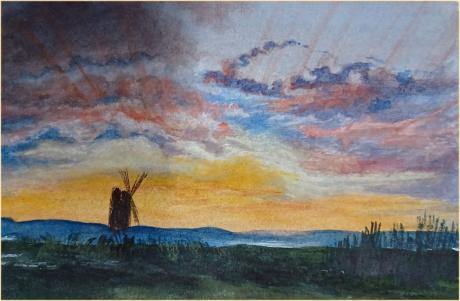signed inscribed and dated
Kenneth Clark, the eminent art-historian and once-director of The National Gallery, wrote, the Petworth Turners ‘show us where to look for what was nearest to his heart. They are not only enchanting in themselves, they are the best introduction to Turner.’
At Petworth Turner was able to enjoy the beauty of the Petworth and its landscape, taking the time to observe, consider and record the great county estate without the usual constraints that were placed on a visitor to such a large house. This freedom to explore and create was encouraged by his enlightened and enigmatic host, George O’Brien Wyndham, third Earl of Egremont (17511 – 1837). Turner's friendship with the Earl allowed him to return year after year, alongside several other artists of the time including John Constable (1776 – 1837) and C. R. Leslie (1794 – 1859).
Petworth held many attractions for Turner, with its majestic landscape, magnificent interiors and wondrous collection. By the later 1820s Turner was somewhat of a fixture at Petworth, and it is in the year 1827 that Turner produced some of the most striking gauche drawings of the interior and inhabitants of Petworth.
However, it was not only the indoors which Turner chronicled, but also the great landscapes of the Estate. Turner is best-known for his stunning landscapes which detail the sky, seas and fields with a considered hand, and his exploration of Petworth was no different. In the 1820s Turner captured the vast landscape of the Estate, depicting the lakes, trees and shrubbery and even the fish he caught – it was known that Turner was a keen fisherman and he took as much opportunity to fish as he did to paint.
Turner’s explorative escapades culminated in a great commission of four final works for the Carved Room from Lord Egremont. Each of the four scenes specially created for placement within the wall carvings, depicts a locale of some significant to the third Earl, including two of Petworth Park, which can be compared with the actual setting they depict, by looking through the windows of the Carved Room which look out to the park.
The other two paintings show the Chain Pier at Brighton and a part of the Portsmouth and Arundel canal, celebrating Lord Egremont’s philanthropy and support of two such progressive schemes. These four can still be seen at Petworth in the original place the third Earl and Turner devised for them, thanks to a restoration project in the early 2000s, which saw the Turner’s reinstated after their removal by Lord and Lady Leconfield in the early 1870s.
Turner’s extraordinary talent combined with the powerful draw to return time and again to Petworth allowed the artist to produce some of the most outstanding pictorial descriptions of the great house and estate, showing us today, almost 200 years later, what life at Petworth was like in his and the third Earl’s time.

